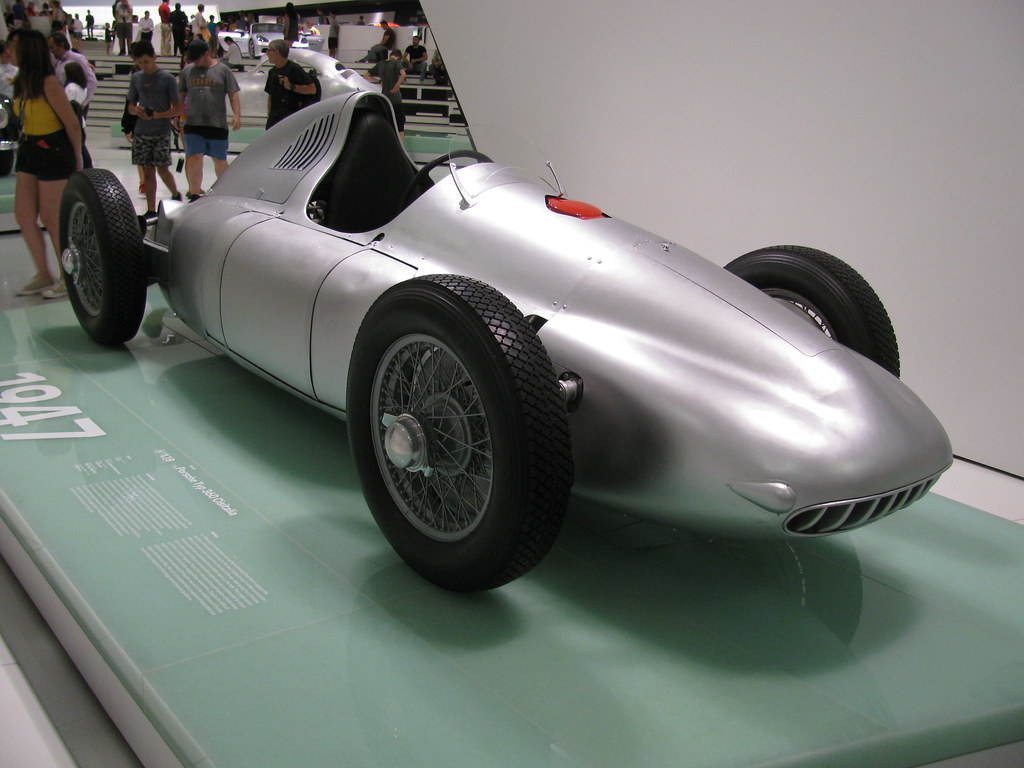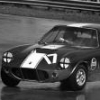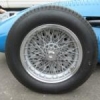
Cooper, Lotus, BRM... or even Bugatti?
#1

Posted 27 July 2019 - 10:09
He states, "Rear-engined Coopers 'grew' into being Grand Prix cars by accident; when faced with the task of building a 'Big car' from scratch Cooper put the engine in front."
Now, it's pretty easy to see how he's reasoned on this. But let's look again.
In 1958 some of those Coopers which 'just grew' started to take out some pretty big races. In 1959 they were showing signs of being the cars to beat and by 1960 that's exactly what they were. The 'big cars' to which Michael alludes are, of course, the Cooper Bristols from the earlier era.
The lineage of their 'growing' includes the sports cars and the single-seater into which Jack Brabham squeezed a Bristol engine in 1955 and ultimately won the Australian Grand Prix. And little else.
But the 1959 showing of these cars, when they finally got a 2.5-litre engine, was such that both Lotus and BRM saw the writing on the wall and started cutting and welding tubes to make new cars in the same pattern. Both were very effective cars in 1960. Ferrari also did one, but it didn't get much of a run, but it was seen as a portent of what might happen in 1961 when smaller engines were required.
So who truly 'realised the future of F1' was in putting the engine in the back? Cooper, who were doing it, Lotus who saw that they were never going to achieve their aims with the 16 or BRM who did an 'about face' to turn out their own Cooper look-alike?
Or was it more properly to be attributed to Bugatti? Or even to the shoe-horn job of Jack Brabham?
Advertisement
#2

Posted 27 July 2019 - 11:45
Let's just say it was Bugatti, he invented everything else in motor sports, didn't he?
More seriously, my claim was certainly a bit simplistic, and not only a bit provocative, but it's not entirely unreasonable, is it? Sure, the rear-engined Coopers were already winning big time in 1958 and '59, but I always felt that the Coopers did not really know they were onto a winning formula until Lotus proved it to them! The Coopers basically 'grew' their 500cc racers to somewhat unreasonable format, while Chapman at once saw the chance for a neat and tidy package that the '18' was. I don't think the lowline Cooper would have made its appearance if not for the Lotus 18, and I wonder whether Charles and John were having thoughts about building a 'proper' (i.e. front-engined) Cooper F 1 to really blow the Italians into the weeds.
#3

Posted 27 July 2019 - 12:47
This is covered in at least one of his biographies.
#4

Posted 27 July 2019 - 15:13
Let's just say it was Bugatti, he invented everything else in motor sports, didn't he?
More seriously, my claim was certainly a bit simplistic, and not only a bit provocative, but it's not entirely unreasonable, is it? Sure, the rear-engined Coopers were already winning big time in 1958 and '59, but I always felt that the Coopers did not really know they were onto a winning formula until Lotus proved it to them! The Coopers basically 'grew' their 500cc racers to somewhat unreasonable format, while Chapman at once saw the chance for a neat and tidy package that the '18' was. I don't think the lowline Cooper would have made its appearance if not for the Lotus 18, and I wonder whether Charles and John were having thoughts about building a 'proper' (i.e. front-engined) Cooper F 1 to really blow the Italians into the weeds.
That really cheered me up on a wet August day. Funniest thing I've heard since someone said Boris Johnson was Prime Minister.
#5

Posted 27 July 2019 - 16:34
Er... Auto Union?
#6

Posted 27 July 2019 - 19:19
Why does no one give Porsche,with the 550 and 718, any credit for contributing to the change from front- to rear-engined racing cars?
#7

Posted 27 July 2019 - 21:07
Thinking quite deeply about what I have just been reading here...I think it's possibly the first time I have seen Michael F (of whom I am a fan) talking nonsense...
DCN ![]()
#8

Posted 28 July 2019 - 02:26
#9

Posted 28 July 2019 - 07:31
![]() Haha, but thank you Doug! It's not the first time, though... https://forums.autos...sale/?p=5667540
Haha, but thank you Doug! It's not the first time, though... https://forums.autos...sale/?p=5667540 ![]()
Edited by Michael Ferner, 28 July 2019 - 07:32.
#10

Posted 28 July 2019 - 08:11
The 1923 Benz Tropfenwagen designed by Edmund Rumpler predates the Auto Unions, Coopers, Bugatti and Porsches.
#11

Posted 28 July 2019 - 09:06
Well, if I interpret Ray's OP correctly, it's not about first usage at all. Neither the Benz nor the Auto Union initiated a trend defining the future of the sport. It was either Cooper or Lotus who made every other constructor of GP cars design vehicles with the engine behind the driver, certainly not Benz, Auto Union, Bugatti or Porsche. The only things I'm not really clear about is whether BRM copied Cooper or Lotus in 1960, and whether Cooper was dedicated to the rear-engined layout, or not. But if Doug says they were, I'm inclined to give credit where it's due - after all, DCN should know a thing or two about Coopers and BRMs...
Edited by Michael Ferner, 28 July 2019 - 09:16.
#12

Posted 28 July 2019 - 09:31
Although these cars, and the Auto-Unions preceded Cooper by many years, there can be no doubt that it was the performance of the Cooper-Climaxes that triggered the switch to rear-engined cars. The key moment was the decision to build the T39 “bobtail” sportscar with engine behind the driver. I can’t see how this evolved naturally from the 500s, especially after the success of the Formula 2 and sports cars. The Coopers, with Owen Maddock and soon afterwards Jack Brabham deserve full credit.
#13

Posted 28 July 2019 - 09:42
All right, gents, I'll readily admit defeat! I was just doing some reading up, and discovered that the BRM P48 was already tested in late 1959 - I'd really forgotten about that! ![]() Also, with the rear-engined Ferrari ready to run at Monaco in 1960, that also points to it being more of a reaction to Cooper than to the Lotus. Please, I humbly implore, ignore my errant ramblings, and proceed as you were...
Also, with the rear-engined Ferrari ready to run at Monaco in 1960, that also points to it being more of a reaction to Cooper than to the Lotus. Please, I humbly implore, ignore my errant ramblings, and proceed as you were... ![]()
![]()
#14

Posted 30 July 2019 - 11:47
If Cooper hadn't been winning I don't believe any of the others would have jumped on the rear-engine configuration. Such as early-60s Indianapolis and Jack Brabham's Cooper, the Zink Trackburner, and Mickey Thompson's car in 1962 - They ran fair-to-OK, not without problems, but for the most part still "kinda weird". Then Lotus showed up with a front-runner and everybody reassessed what they needed to get an advantage over most of the rest of the field. Until the next race, anyway.
#15

Posted 30 July 2019 - 16:30
All right, gents, I'll readily admit defeat! I was just doing some reading up, and discovered that the BRM P48 was already tested in late 1959 - I'd really forgotten about that!
Also, with the rear-engined Ferrari ready to run at Monaco in 1960, that also points to it being more of a reaction to Cooper than to the Lotus. Please, I humbly implore, ignore my errant ramblings, and proceed as you were...

I've often thought that Chapman was uncharacteristically slow to react to the concept when you consider that his front-engined MkXI (IIRC) competed aginst Hans Herrman's 550 Spyder in the British GP support race at Aintree in 1955.
Edited by cpbell, 31 July 2019 - 10:56.
#16

Posted 30 July 2019 - 19:18
#17

Posted 30 July 2019 - 19:43
#18

Posted 30 July 2019 - 20:13
http://www.wsrp.cz/intgb1954.html#6
#19

Posted 31 July 2019 - 10:58
Herrmann did compete in the support race for the 1954 British GP. He took pole position, but finished third behind the Lotuses of Chapman (Mk VIII) and Peter Gammon (Mk VI).
http://www.wsrp.cz/intgb1954.html#6
That was the one I was thinking of - it was the MkVIII. What I meant was that I'm surprised that Chapman didn't try to find a suitable gearbox in 1959 given that he'd had experience of racing against a mid-engined car as early as 1954.
Advertisement
#20

Posted 31 July 2019 - 12:28
Though it seems surprising to me that nobody simply went to Porsche.
#21

Posted 31 July 2019 - 17:04
It may even be the case that Dr Porsche delayed the adoption of rear engined racing cars rather than accelerated it. It was his lethal swing axle rear suspension, intially on Auto Unions, which gave rise to the myth that rear engine cars were difficult to control.
#22

Posted 31 July 2019 - 18:04
Edit: Answered my own question, no except for the lower output cars. Could not find real torque limit numbers but general opinion is that those boxes were good for what they were intended for and not much more. The housings pre 1960 were split in half side to side which by itself would have been trouble with more torque let alone the parts inside. This link has interesting details on various configurations of this transaxle.
https://www.thesamba...ic.php?t=658674
Edited by Bikr7549, 31 July 2019 - 20:48.
#23

Posted 31 July 2019 - 22:26
With new gears they were reasonably durable up to 1.5-litres, some were even behind early Twin Cams.
#24

Posted 31 July 2019 - 23:23
#25

Posted 31 July 2019 - 23:29
Later Garrie became a distributor of Hewland boxes and used the Mk 5 (the strongest of the Hewland/VW range?) but swung over to FT200s after suffering a failure in the Twin Cam days.
But I would think that Porsche boxes, even by the mid-fifties, were stronger than VW.
Meantime, there have been cars with V8 engines which have raced with modified VW boxes.
#26

Posted 01 August 2019 - 06:40
#27

Posted 01 August 2019 - 07:52
Cooper used a Heavily modified Renault unit did they not? They cost a pretty packet as well, unfortunately when Chapman did do his own box it was the queerbox, that was not very reliable.
The gearbox that Cooper used was a developed Citroen 'box. Without looking it up, I'd say that part of that development would have been making it a four-speeder but at least it started as a stronger unit than the VW or Renault 4CV.
#28

Posted 01 August 2019 - 09:07
It was said at the time that Chapman delayed building a rear engined car because he didn’t want to be accused of copying Cooper. The appearance of the P48 might have played some part in his decision to build the 18.
#29

Posted 01 August 2019 - 10:02
Ersa - or is that ERSA? - made the Citroen boxes and Cooper had some gears made to give four speeds and make them more raceworthy. Was that the box in Jack's Bristol-powered car?
Later they used a gearbox made by Jack Knight, if I recall.
One of the problems with the queerbox, something that made it appear unreliable, was that it was a demon to set up with spacers and washers between gears that had to be just right. I know that Grant Gibson ultimately cut up a second case to use as a dummy so he could get his set up right, correcting issues that it had had for thirty or forty years.
The crownwheel also wore with age, I doubt that would have been a problem in 1960 or 1962, but older cars by 1964 were in trouble and couldn't get spares readily. The Gibsons modified a Vauxhall crownwheel (ran it overnight in the lathe with valve lapping paste) to produce their own replacement.
#30

Posted 01 August 2019 - 10:21
The gearbox that Cooper used was a developed Citroen 'box. Without looking it up, I'd say that part of that development would have been making it a four-speeder but at least it started as a stronger unit than the VW or Renault 4CV
Citroen ERSA... Now it comes back to me!
John Cooper had to hide the bills from the old man as he would have blown his top at the cost, won 2 championships mind you...
That period of motorsport was very fast moving and innovative so I think it's pretty hard to say who came up with what first.
I must dig out Mr Nye's Cooper Cars again for a reread so I can enjoy the brilliance of it all again!
#31

Posted 01 August 2019 - 10:49
As I understand, Cooper used ERSA modified Citroen gearboxes from the first Climax engined car, the T39 "Bobtail" sportscar. The original Citroen 'box had three speeds and ERSA sold a four speed conversion. For Cooper, they produced a close-ratio version. The Brabham-inspired strengthening to the casing appeared in 1958 to cope with the enlarged Climax engines. The first one arrived just in time to be fitted to Rob Walker's car before it was shipped to Argentina.
From 1960, Cooper used their own gearbox, designed by Owen Maddock, built by Jack Knight and paid for by Charles Cooper, much to his disgust.
#32

Posted 01 August 2019 - 11:02
As I understand, Cooper used ERSA modified Citroen gearboxes from the first Climax engined car, the T39 "Bobtail" sportscar. The original Citroen 'box had three speeds and ERSA sold a four speed conversion. For Cooper, they produced a close-ratio version. The Brabham-inspired strengthening to the casing appeared in 1958 to cope with the enlarged Climax engines. The first one arrived just in time to be fitted to Rob Walker's car before it was shipped to Argentina.
From 1960, Cooper used their own gearbox, designed by Owen Maddock, built by Jack Knight and paid for by Charles Cooper, much to his disgust.
We also have the Colotti gearbox which was used by Cooper F1 customers such as Rob Walker. As I recall, customers could buy a chassis but the improved gearbox (Cooper/ERSA or Cooper/Knight or both?) was works-only. Like Lotus, Colotti found it harder than expected to build a reliable gearbox.
#33

Posted 01 August 2019 - 11:22
A pity Tatra were on the wrong side of the Curtain - their gearboxes cut their teeth (sorry!) on handling the torque from big rear-mounted V8s.
Ah, Mr Bond, we have an unusual task for you ...
#34

Posted 01 August 2019 - 11:31
It may even be the case that Dr Porsche delayed the adoption of rear engined racing cars rather than accelerated it. It was his lethal swing axle rear suspension, intially on Auto Unions, which gave rise to the myth that rear engine cars were difficult to control.
Yup. The M-B W25 had swing axle rear suspension and slightly more favourable weight distribution -- and it certainly looks like a handful to drive too. The initial P-Wagen/Type A design was very much a prototype or concept car. Porsche's team stuck with it (even though Porsche had been working on more conventional designs) and made it a success.
Modern analysis of Auto Union performance and characteristics is informed by data which was unavailable in the 1950s. If you read assessments of the AU cars such as Pomeroy's and of rear engined road cars (which would have been available to Chapman and Maddock), you don't get the clues why rear engine should work in 1950s F1. The benefits of reduced frontal area, lower weight and simplified drive train are things that Maddock and Chapman worked out for themselves.
#35

Posted 01 August 2019 - 12:17
The benefits of reduced frontal area, lower weight and simplified drive train are things that Maddock and Chapman worked out for themselves.
But frontal area is governed by wheel & tyre size and driver and engine bulk, the way that these things are distributed won't have much effect on the actual area. So any advantage would have been from a more aerodynamically advantageous frontal entry, and not frontal area, which would have been much the same for both front and rear engined cars. Engines don't grow in size if they're situated in front of the driver, though inevitably, they make overall packaging more of a problem.
#36

Posted 01 August 2019 - 12:44
But frontal area is governed by wheel & tyre size and driver and engine bulk, the way that these things are distributed won't have much effect on the actual area. So any advantage would have been from a more aerodynamically advantageous frontal entry, and not frontal area, which would have been much the same for both front and rear engined cars. Engines don't grow in size if they're situated in front of the driver, though inevitably, they make overall packaging more of a problem.
Driver bulk is typically increased for a front engined car owing to the drive shaft. Unless the shaft is alongside the driver (e.g. Mallock), a front engined car is always taller. The 1958 Coopers raced with a 2.0 litre Climax engine -- less fuel bulk, smaller cooling requirements. Packaging steering and engine (and often gearbox) in the same chassis zone was a problem that few designers cracked -- the Lotus 7 is a notable exception.
The rear engine advantage is most evident when you look at Formula Junior cars.
#37

Posted 01 August 2019 - 13:12
How much weight was said by a rear-engined car? Tony Rudd wrote that the P48 was heavier than the P25. In part this was due to the need to modify existing components but he said the the only weight saving was the propshaft at 3.4kg "which almost equalled the hydraulic clutch mechanism and longer pipe runs".
#38

Posted 01 August 2019 - 14:19
Their problem, as Moss learned, was that gears hadn't been cut according to Colotti's drawings.
I'm thinking that the Colotti-Francis box was a development of the off-season between 1959 and 1960. Can anyone put any more accurate dating on that?
#39

Posted 01 August 2019 - 14:24
Advertisement
#40

Posted 01 August 2019 - 15:03
Gents...you forgot one.
https://thechicane.c...nged-gp-racing/
I didn't think of it either until I stood in front of it yesterday when I visited the Porsche museum.

#41

Posted 01 August 2019 - 15:04
#42

Posted 01 August 2019 - 15:19
But while we're talking about gearboxes, didn't many of the front-engined cars have transaxles anyway?
#43

Posted 01 August 2019 - 15:39
But while we're talking about gearboxes, didn't many of the front-engined cars have transaxles anyway?
That's a good point and I can't think of a 1950s GP car that didn't.
#44

Posted 01 August 2019 - 15:44
Edited by Bikr7549, 01 August 2019 - 16:06.
#45

Posted 01 August 2019 - 16:05
Driver bulk is typically increased for a front engined car owing to the drive shaft. Unless the shaft is alongside the driver (e.g. Mallock), a front engined car is always taller. The 1958 Coopers raced with a 2.0 litre Climax engine -- less fuel bulk, smaller cooling requirements. Packaging steering and engine (and often gearbox) in the same chassis zone was a problem that few designers cracked -- the Lotus 7 is a notable exception.
The rear engine advantage is most evident when you look at Formula Junior cars.
Nonsense. Several designers found ways around the prop shaft problem, it didn't always have to be right under the driver's groin, but in the front-engined era, drivers almost always sat bolt upright, and that's the reason for higher drivers. Lighter steering with less weight on the front wheels of rear-engined cars lightened the steering, less muscle power was needed, with the result that drivers could recline more and more, and that reduced frontal area. Now of course they have power steering, which means that they can almost lie flat, though I'm sure that puts even more strain on their neck muscles. When the Tyrrell P34 appeared, less educated writers wittered on about smaller front tyres reducing frontal area. Utter bollocks. Viewed from the front the car had exactly the same cross sectional area as all its competitors, those smaller front wheels probably had only a marginal benefit on drag, but the cars did have a better frontal entry.
#46

Posted 01 August 2019 - 20:49
Gents...you forgot one.
No, not at all. The Cisitalia hardly changed the future of Grand prix racing. Again, it's not about the first because that discussion is quickly over: Peugeot in 1895. It didn't make Panhard-Levassor put the engine in the rear, though, much like Benz failed to influence Fiat or Auto Union Mercedes-Benz. Who built a rear-engined car after seeing the Cisitalia???
#47

Posted 01 August 2019 - 21:27
Gordini?That's a good point and I can't think of a 1950s GP car that didn't.
This all depends on what you mean by a transaxle. Certainly, most cars had the gearbox in a unit with the differential but there considerable variation. Many had the gearbox behind the differential but others had a transverse gearbox. The Vanwall had the gearbox in front of the differential, under the driver’s seat, hence the great height of the car.
The Vanwall gearbox was a joint effort between Porsche and Vandervell Products. Porsche designed the gear cluster and provided synchromesh. Getrag GmbH manufactured the gears. A Vandervell casing was used.
#48

Posted 01 August 2019 - 21:33
Engines were, generally, higher than a driver's feet.
#49

Posted 01 August 2019 - 23:14
Pomeroy data for the 1.5/4.5 cars
1947-51 Alfa 158, 10
1947 Cisitalia, 10.5
1951 Ferrari 4.5, 10.75
1953 BRM, 10
Setright data for 2.5 L cars
1954 W196, 10.5 (not sure if this is for the closed or open wheel car)
1954 Maserati 250F, 12
1954 Lancia D50, 13
1955 Ferrari 555, 10
1956 Lancia Ferrari, 13.2
1958 Vanwall, 12.5
1957 Maserati 250F, 11
1958 Ferrari 246, 10
1959 BRM Type 25, 11
1959 Cooper (2.5 L), 9.5
1960 Lotus Type 18 (2.5 L), 9
Average for the early cars is 10.2 sq feet and 11.5 for the 2.5 cars (excepting the Cooper and Lotus).
Interesting that the cars got so much larger for the 2.5 L rules even tho engine power was reduced-the Alfa had 380 hp and the W196 256. Rear tire sizes may have increased, but they were pretty constant width wise (6.5-7.0) thru the 2.5 era, tho wheel diameter reduced to 15" for the Cooper and Lotus from 16" on the early cars.
Also interesting is that the Cisitialia was no different frontal area wise than its front engine competitors-not sure what is up with that. The Lancias certainly were large cars-didn't the fuel tanks stick out past the wheels to a certain degree? Filling the normally open gap between inner wheel width and the body might be the issue here. With the Vanwall wasn't the aero plan that shape was more important than size? I have not seen a W196 in the flesh but in pictures it always seemed to be a very dense package, which if correct would account for its low area.
Unless there was some other change made for the mid engine cars this points to the basic layout providing better packaging from a frontal area perspective.
Edit-since I was back in the time tunnel anyway I thought I would add some more frontal area measurements FYI;
Pomeroy data
1924 Bugatti Type 35, 10.8
1930 Bentley 4.5, 17
1932 Alfa P3, 10.25
1934 MB W25B, 11.8
1936 AU Type C, 10.8
1937 MB W125, 12.5
1939 MB W163, 12.5
Edited by Bikr7549, 02 August 2019 - 02:13.
#50

Posted 02 August 2019 - 00:06
Making the most they could of it and using an aerodynamicist.
























